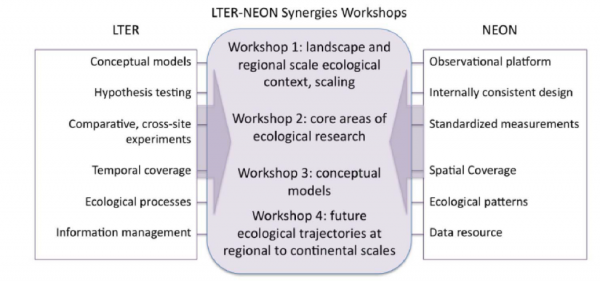An LTER-NEON Synergies workshop, held March 29-31, explored the potential for strengthening and deepening the relationship between these two major research organizations and expanding ties to other networks such as the Critical Zone Observatory (CZO), Long Term Agricultural Research (LTAR) and Global Lake Ecological Observatory (GLEON) networks. The Long-Term Ecological Research (LTER) Network and National Ecological Observatory Network (NEON) have complementary approaches to long-term, large scale ecological research and improving coordination offers great potential for shared learning.
“Understanding the causes and consequences of ecological change is one of the most important challenges confronting the scientific community,” said Tim Kratz, National Science Foundation Program Officer for Macrosystems Biology and Early NEON Science. “This workshop to explore synergies between NEON and LTER helped clarify areas where these two powerful approaches can be brought together to make significant progress to meet this challenge.”
Subscribe to LTER newsletter | Subscribe to NEON newsletter
Twenty-four workshop participants—including senior organizational leadership and a wide assortment of data users—met at the National Center for Ecological Analysis and Synthesis (NCEAS) to discuss how the different lenses each network employs could provide perspective for the other. “Workshop participants were able to highlight exciting synergies between LTER and NEON that will develop over the next 30 years,” said workshop organizer Peter Groffman, who chairs the LTER Science Council. “Perhaps the key synergy is that NEON is going to provide important new information on how ecosystems are changing and LTER will continue to provide understanding of the mechanisms underlying that change.”
As participants in the LTER-NEON Synergies workshop introduced themselves and their connections to LTER and NEON, it was striking how many individuals had launched their careers through undergraduate or graduate research experiences at LTER sites—manipulating plant diversity at Cedar Creek, sorting litter at Harvard Forest, harvesting biomass at Toolik Lake, and so on. The intimate knowledge of site and system represented by those experiences is central to the work of the LTERs, where teams of site-based scientists guide experiments and data collection based on Network-wide research themes, such as primary production, movement of organic matter, movement of inorganic matter, population dynamics and trophic interactions, and disturbance.

NEON, on the other hand, offers a suite of measurements across many sites with standardized data collection from sensors located on towers, in the soil, and in aquatic systems, sampling of select organisms, including small mammals, insects, fish, plants, invertebrates, and microbial communities, and remote-sensing data collected by airborne observatories. The top-down approach implemented by NEON produces a large body of highly comparable data, but offers less flexibility for addressing site-specific questions. With up to 14 co-located LTER and NEON sites, there are obvious opportunities for data sharing and interpretation, but the discussion went deeper to address approaches for
- applying LTER’s understanding of land use history, landscape organization, scales of ecological organization, and disturbance regimes, for example, to help interpret NEON data and sampling designs, and
- using NEON data, with its finer temporal resolution, new organisms, and disease focus, to help interpret and expand the scope of LTER core research areas.

Participants outlined a journal article describing concrete approaches and describing examples of these types of synergy. “This was a fun and challenging workshop bringing together diverse perspectives on how the LTER and NEON scientific networks can synergize,” said Cove Sturtevant, NEON Staff Scientist. “We made a lot of progress toward a blueprint that I think can accelerate the use of NEON data in impactful science as the Observatory reaches full operability.”
The workshop also examined the role of conceptual and quantitative models in guiding a new era of continental scale ecological research. The discussion focused on how LTER and NEON offer opportunities to think about the nature of prediction and uncertainty. The wealth of long-term data from LTER sites in almost all NEON domains could, for example, help NEON scientists to interpret the variability and extremes that they observe as sites begin to accumulate new data streams.
Researchers discussed a variety of approaches to modeling and prediction, including conceptual frameworks, scenarios, and model intercomparison/data assimilation. A follow-up workshop is being planned to dig deeper into the potential for syntheses of LTER and NEON models and data as well as for involving other networks.
Participants at the workshop included a core organizing committee—drawn from LTER and NEON leadership, with representation from many co-located research sites—and also a wide range of junior researchers and data users. Recognizing the importance of engaging the next generation of ecological leaders, organizers invited applications from throughout the ecological research community. Over 60 researchers applied for one of the 11 slots.











